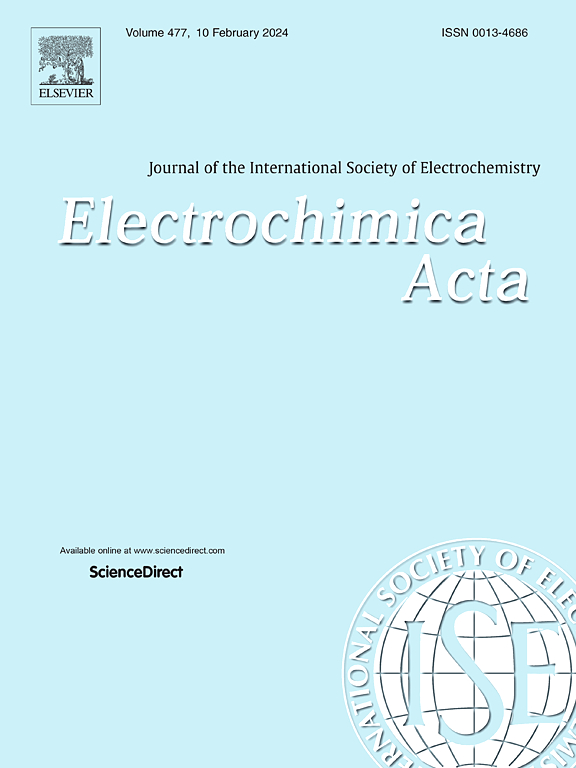关于呋喃和噻吩功能化锌卟啉作为电化学储能系统高性能有机阴极的第一原理计算见解
IF 5.6
3区 材料科学
Q1 ELECTROCHEMISTRY
引用次数: 0
摘要
在金属离子电池(MIB)中,有机电极材料(OEM)因其成本效益和环境兼容性,正逐渐取代传统的无机电极材料。基于卟啉的材料,尤其是金属卟啉(M-Porph),因其双极电化学反应性,使其既适合作为阴极材料,也适合作为阳极材料,在电化学储能系统(EESS)中备受关注。然而,它们的结构与性能之间的相关性还需要进一步探索。本计算研究考察了具有呋喃和噻吩取代基的锌(II)-卟啉(Zn-Porph)的氧化还原特性、热力学和理论性能。噻吩取代呋喃后,Zn-Porph 的氧化还原电位(E°)变化了 0.17 V。噻吩使 LUMO 稳定了 0.105 eV,表明电子亲和力增强,电子接受过程加快,而 HOMO 稳定了 0.085 eV。热力学计算显示,锌(II)-噻吩-卟吩还原过程中间产物的稳定性(ΔΔG° = 0.12 eV)低于呋喃,这表明电化学过程更快。此外,Zn-T18 的状态密度(DOS)分析表明,费米能处的 DOS 不为零,这表明存在可占据的电子状态,并突出了其导电特性。与 PF6¯ 复合后,费米级发生移动,反映了电子状态的重新分布和稳定。氧化型 Zn-T16 尽管费米级发生了显著的偏移,但在费米能处仍保持了非零 DOS,从而确保了持续的电子导电性。这些发现强调了锌卟啉阴极在 EESS 中的稳健性和多功能性,证明了它们在满足高效、经济和环保型能源存储解决方案需求方面的潜力。本文章由计算机程序翻译,如有差异,请以英文原文为准。
First-principle computational insights on Furan- and Thiophene- functionalized zinc-porphyrins as high performance organic cathodes for electrochemical energy storage systems
Organic electrode materials (OEMs) are increasingly replacing conventional inorganic counterparts in metal ion batteries (MIBs) due to their cost-effectiveness and environmental compatibility. Porphyrin-based materials, particularly metalloporphyrins (M-Porph), have garnered significant attention for electrochemical energy storage systems (EESS) owing to their bipolar electrochemical reactivity, making them suitable as both cathodic and anodic materials. However, the correlation between their structure and performance needs further exploration. This computational study examines the redox properties, thermodynamics, and theoretical performance of Zinc(II)-Porphyrin (Zn-Porph) with furan and thiophene substituents. The redox potential (E°) of Zn-Porph changes by 0.17 V with thiophene substituents instead of furan. Thiophene stabilizes the LUMO by 0.105 eV, indicating enhanced electron affinity and faster electron-accepting processes, while the HOMO shows a 0.085 eV stabilization. Thermodynamic calculations reveal that the reduction process intermediates for Zinc(II)-thiophene-Porph are less stable (ΔΔG° = 0.12 eV) than those for furan, suggesting a more accelerated electrochemical process. Additionally, density of states (DOS) analysis of Zn-T18 shows a non-zero DOS at the Fermi energy, indicating available electronic states for occupancy and highlighting its conductive properties. Upon complexation with PF6¯, the Fermi level shifts, reflecting electronic state redistribution and stabilization. The oxidized form, Zn-T16, retains a non-zero DOS at the Fermi energy despite significant Fermi level shifts, ensuring continued electronic conductivity. These findings underscore the robustness and versatility of Zn-porphyrin cathodes in EESS, demonstrating their potential to meet the demands for efficient, cost-effective, and environmentally friendly energy storage solutions.
求助全文
通过发布文献求助,成功后即可免费获取论文全文。
去求助
来源期刊

Electrochimica Acta
工程技术-电化学
CiteScore
11.30
自引率
6.10%
发文量
1634
审稿时长
41 days
期刊介绍:
Electrochimica Acta is an international journal. It is intended for the publication of both original work and reviews in the field of electrochemistry. Electrochemistry should be interpreted to mean any of the research fields covered by the Divisions of the International Society of Electrochemistry listed below, as well as emerging scientific domains covered by ISE New Topics Committee.
 求助内容:
求助内容: 应助结果提醒方式:
应助结果提醒方式:


